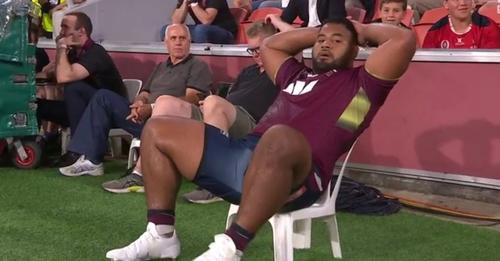Getting a Rugby red card is a pretty simple one because it is the same as most other sports. But the rules around a yellow card in Rugby are different and it is why the term Sin Bin was created.
What is a sin bin in Rugby? In Rugby, if a player is sent to the sin bin it means they have to leave the field for 10 minutes due to being given a yellow card for disciplinary reasons. This means their side will be numerically disadvantaged for the duration of the time penalty.

The Sin Bin is not a real place. Many people hear the term Sin Bin and believe that it is a real place. But it is more just a term that has become popular in Rugby. When a player is sent to the sin bin it means they have been awarded a yellow card and they need to leave the field for 10 minutes.
Some people look at the sin bin as the seat that players will usually sit on for the ten minutes that they are off the pitch, but there is not usually a designated place for players to go, they just need to be off the field. Players do not return to the sin bin if they get a second yellow card as two yellow cards mean a player gets a red card.
The term sin bin is not just used in rugby, as hockey is another sport where sin bin is seen as the place that players go when they are sent off.
Why would a rugby player get sent to the sin bin?
There are quite a few different reasons why a rugby player would be sent to the sin bin. A player is sent to the sin bin for 10 minutes if they are given a yellow card and there are various different ways that you can get a red card in rugby.
1. Intentional knock-on
One of the most common reasons for a yellow card that we are seeing at the moment is for an intentional knock-on. If a player is adjudged to have intentionally knocked the ball on or knocked the ball on when not in a position to gather the ball, it is given as a penalty to the other team as an intentional knock-on.
This on its own is not a yellow card offence. What makes it a yellow card offence is when this prevents the attacking team from making a line break. If there was the opportunity for a line break then a yellow card will be awarded to the player who intentionally knocked on the ball.
It is also one of the more controversial rules that end in a yellow card. The controversy comes from the intention. It is incredibly rare that a player is intentionally trying to knock the ball forwards. Yellow cards are often awarded when players make a lunge for the ball that they are not going to get to and the yellow card can be seen as harsh because there is no malice in a player reaching out to try to catch the ball.
2. Conceding a penalty try
A penalty try is awarded when the referee decides that an infringement directly prevented a try. The most common way this is done is when a maul is brought down illegally by the defending team or an intentional knock-on prevents an attacker from going over the try line.
If the referee is able to identify the player that prevented the try then a yellow card must be awarded alongside a penalty try. It is why you will see the player that collapsed a maul that looked like it was going to end in a try will be given a yellow card, as well as the penalty try being awarded.
3. Cynical play
A yellow card for a cynical infringement is something we see in both football and rugby. Essentially it means that when a player commits an infringement, they can be awarded a yellow card if the referee judges that the player infringed to prevent an opposition attack.
Not rolling away or hands in the ruck are both common fouls which see players given yellow cards if they are deemed to be cynical. Both of these are ways that defending players illegally slow down the ball for the attacking team and give their fellow defenders longer to get back into position.
4. Dangerous hits with mitigation
The process of dealing with a hit to the head or neck has changed a lot for rugby over the years, but there is now criteria for the referees on how they are supposed to discipline players for a hit to the head or neck area.
If there is a hit to the head or neck, it will usually be reviewed by the TMO to determine the point of contact, the force used and if there is any mitigation. If the point of contact is to the head or neck, considerable force is used and there is no mitigation then it is a red card. A yellow card will be awarded if one of these is not the case.
Mitigation is seen as the player who gets hit dropping in height suddenly, usually due to an initial tackler or a player changing direction suddenly. It is also awarded if the hit is not seen to use a lot of force or the hit is not directly to the head or neck as referees will start at a red card and work down depending on the factors given.
5. Repeated infringements
When a team is under a lot of pressure defending their try line, they will often commit different offences to prevent the attacking team from scoring a try. While they will be penalised for this, most teams would prefer a penalty to a try.
It is why a team will be given a yellow card for repeated infringements. Usually, if a team commits multiple infringements in a short space of time, a referee will give them a warning. The player who then commits an infringement after that warning will usually be given a yellow card. Repeated infringements is also an offence for players.
